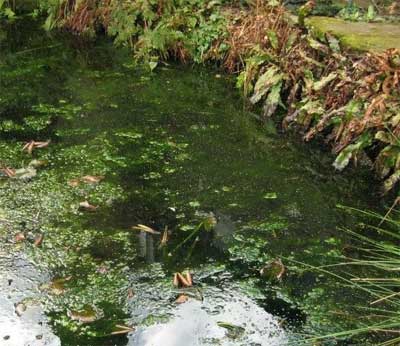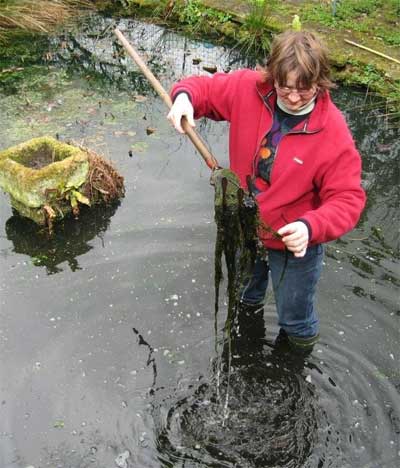Swamped
By Ruth D’Alessandro, The Wildlife Gardener Just a few things reduce the Wildlife Gardener to tears: traumatic news stories, the end of The Snowman, most of Billy Elliot, Simon getting fired from The Apprentice … but most of all the Wildlife Pond, full of tadpoles, turning to a foetid swamp of stringy algae and blanketweed.

What has happened? Only a couple of weeks ago, The Wildlife pond was a bubbling jacuzzi of amphibian procreation as frogs and newts churned the waters in an ecstasy of spawning. Now, the hatched tadpoles (thousands of them, admittedly) are stranded in two tiny clear patches of water in the midst of this foul-smelling green mess. I pulled out some of the gunge with a net, but found I was pulling out live tadpoles, so inextricably wound up in the slime they could not be released unharmed. And that’s when the tears came ” amphibians are threatened enough already without me wantonly murdering their offspring. So, on the advice of a local friend who has an incredibly fecund pond stuffed with frogs, toads and great crested newts, I bought some wildlife-friendly anti-algae pond dye and sludgebuster from the garden centre. The Wildlife Pond turned an alarming shade of blue and The Ranger emailed me to say that pond dye, although inert, would probably unbalance the ecosystem dependent upon sunlight at the bottom of the pond. I had now ruined my precious, beloved freshwater environment, everything would die and it would ALL BE MY FAULT… But I underestimated the power of the pond. Two sunny days later the blue colour had all gone, and thousands of tadpoles were sunbathing in the two gaps in the algae. Relieved, and feeling I owed it one, I decided to get down and dirty in the pond with a rake and try to sort out the algae manually:

I pulled out loads of snotty green stuff, rinsing it in a bucket of clear water to release as many tadpoles as possible. Happily, most of them were staying put sunbathing, and I rescued a fair few others. Apparently, algae and blanketweed form when there is too much nutrient in a pond. The Wildlife Pond has a thick layer of decayed oak leaves at the bottom, and probably not enough oxygenating plants. Add to this a large volume of protein-rich hatched frogspawn jelly and you have the makings of a swamp. The previous owner assures me that the algae disappears later on in the summer. I know that I have to invest in some thigh waders. I need to do a serious autumn slub-out of the sunken leaves and detritus when most of the inhabitants have left and before the hibernators tuck themselves up. So that’s October’s post sewn up!
- Spurn Spawn! - 26th February, 2014
- Bluebells on wheels: axles of evil? - 2nd February, 2011
- Raising the ba: Wildlife and the Ancient Egyptian Book of the Dead - 8th January, 2011

Thank you, Colin. It may be that the frogs, having done their reproductive stuff, have now gone off to forage outside the pond. I’m finding frogs on the veg patch and the front garden now. You may have been unlucky and your frogspawn froze (you don’t say how far north you are), in which case no tadpoles will have hatched. The Wildlife Pond on first inspection looks devoid of tadpoles, but in fact they have spread themselves all around the pond, especially at the bottom around the plants.
Please let me know if you find any tadpoles!
Good luck with your pond.
Our problem is that late Feb we had the usual if rather early frog activity in our pond and plenty of spawn but following a rather bleak spell of weather in March the pond has become completely devoid of both Frogs and spawn. Plant life appears normal and water clarity also fine.
Any ideas.
Colin
Hi Jack! I like the massive wasp too…from a distance.
I also saw a dung beetle about 1 or 2 years ago
rolling some poo up the hill. Have you got any pictures of dung beetles?
The Ranger responds: I don’t have a picture but I do have a link to tell you more about UK dung beetles just like the one you saw: see here.
i like the massive wasp!!!!!!!!!!
Thank you, folks – I’ll give barley straw a go, and apparently I can also use lavender clippings! Well, that would disguise the smell….
Barley straw seems to be a popular solution – albeit as Rupert correctly says a long-term one – for this problem. See a very full analysis here.
Try a long ‘sock’ of barley straw to reduce the blanket weed, etc. Needs renewing every 6 months, in spring and after autumn slubbing. May take 3 year to eradicate the problem but here’s hoping.
Surprisingly, not as badly as I was expecting. More of an organic sludgy smell, which gives me hope that the pond is intrinsically quite healthy, but in need of a little TLC.
did it smell awful there!?